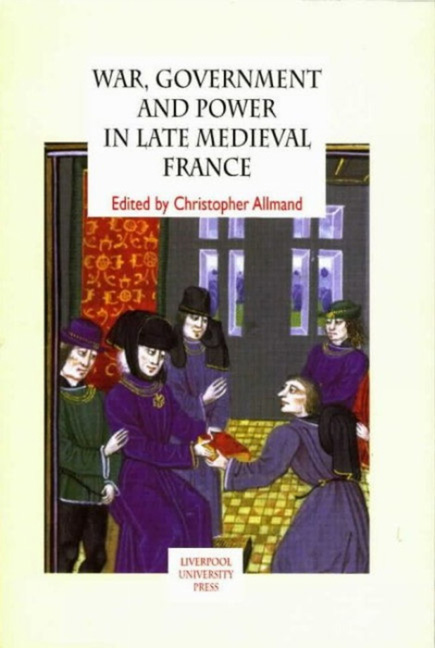Book contents
- Frontmatter
- Contents
- Dedication
- Acknowledgements
- Abbreviations
- Introduction
- 1 From the Court of Hainault to the Court of England: The Example of Jean Froissart
- 2 Froissart and his Second Book
- 3 Alain Chartier and the Arts of Crisis Management, 1417–1429
- 4 Intellectual Patterns and Affective Reactions in Defence of the Dauphin Charles, 1419–1422
- 5 War, Propaganda and Diplomacy in Fifteenth-Century France and England
- 6 History and the Literature of War: The Boke of Noblesse of William Worcester
- 7 Commynes on Kingship
- 8 ‘Centre’, ‘Power’ and ‘Periphery’ in Late Medieval French Historiography: Some Reflections
- 9 Centre and Periphery in Late Medieval France: Tournai, 1384–1477
- 10 ‘Decayed Feudalism’ and ‘Royal Clienteles’: Royal Office and Magnate Service in the Fifteenth Century
- 11 Justification and Theory of the Death Penalty at the Parlement of Paris in the Late Middle Ages
- 12 Membra disjecta of the Breton Chambre des Comptes in the Late Middle Ages: Treasures Revisited and Rediscovered
- Glossary
- Index
11 - Justification and Theory of the Death Penalty at the Parlement of Paris in the Late Middle Ages
- Frontmatter
- Contents
- Dedication
- Acknowledgements
- Abbreviations
- Introduction
- 1 From the Court of Hainault to the Court of England: The Example of Jean Froissart
- 2 Froissart and his Second Book
- 3 Alain Chartier and the Arts of Crisis Management, 1417–1429
- 4 Intellectual Patterns and Affective Reactions in Defence of the Dauphin Charles, 1419–1422
- 5 War, Propaganda and Diplomacy in Fifteenth-Century France and England
- 6 History and the Literature of War: The Boke of Noblesse of William Worcester
- 7 Commynes on Kingship
- 8 ‘Centre’, ‘Power’ and ‘Periphery’ in Late Medieval French Historiography: Some Reflections
- 9 Centre and Periphery in Late Medieval France: Tournai, 1384–1477
- 10 ‘Decayed Feudalism’ and ‘Royal Clienteles’: Royal Office and Magnate Service in the Fifteenth Century
- 11 Justification and Theory of the Death Penalty at the Parlement of Paris in the Late Middle Ages
- 12 Membra disjecta of the Breton Chambre des Comptes in the Late Middle Ages: Treasures Revisited and Rediscovered
- Glossary
- Index
Summary
Our perception of the Middle Ages is influenced by what we regard as acts of cruelty carried out in the name of justice, the most significant of these being the death penalty. Historians associate it with the gallows which, from the twelfth century, feature prominently on the social and political scene. This approach has been developed partly as a result of the researches of Michel Foucault, who has underlined the large increase in the number of executions carried out since that time. The philosopher would argue that capital punishment was a political instrument (operateur politique) which emphasised the power of the ruler. But Foucault's conclusions were largely based on specific cases, above all political crimes, and those concerned with treason, and on the penalties which came to be associated with them. Could one really apply the same punishments associated with particular crimes, such as those meted out under Philippe le Bel to punish the lovers of the king's daughter-in-law who were flayed alive before being quartered, beheaded and hanged, or those imposed during periods of civil unrest when traitors were beheaded and their bodies exposed at the gates of towns (some of these being on the very frontiers of the kingdom) to the majority of criminal cases which might theoretically end in the passing of a death penalty? Various types of crime are often considered together, and the inevitable conclusion of terrible repression is all too readily drawn. However, Michel Foucault took care to distinguish treason (lèse majesté), a crime whose character would be developed in the late Middle Ages, from more ‘everyday’ crimes such as homicide or theft which, in certain cases, could also attract the death sentence, albeit one of a different kind: death by hanging carried out according to an altogether different ritual. The conclusions reached by Michel Foucault do not bear generalisation, even those which concern the crime of treason which sometimes led to other outcomes, such as the grant of a royal pardon.
- Type
- Chapter
- Information
- War, Government and Power in Late Medieval France , pp. 190 - 208Publisher: Liverpool University PressPrint publication year: 2000



